|
KOREAN KANHWA SŎN BUDDHISM -- SPECIAL REPORT
|
|

Top Menu
Intro Page
|

Architecture
25 Photos
|

Creatures
 42 Photos 42 Photos
|

Deities
59 Photos
|

Doors
13 Photos
|

Paintings
60 Photos
|

People
32 Photos
|

Votive Icons
21 Photos
|
|
Also See

|
Korean Influence on Early Japanese Buddhism. Not a systematic study, but rather a "sketch" of the key contributions of Korean monks, artisans, and specialists to early Japanese Buddhist doctrine, art, and architecture. 30 Photos.
|
|
SUPERNATURAL CREATURES. Buddhism was introduced to China via India/SE Asia in the 1st and 2nd centuries CE. It arrived in Korea via China/Central Asia in the 4th century, and came last to Japan via Korea in the mid-6th century. Although Japan first learned of Buddhism from Korea and relied on Korean immigrants to build its first temples and carve its first sculptures, the subsequent development of Japanese Buddhism and Buddhist sculpture was primarily influenced by China. The three nations, despite their modern-day animosity toward each other, all share a common heritage, wherein China's tradition played a seminal role. Today the three still share similar mythology and religious artistic traditions, yet the development of Buddhism in each nation was "molded and customized" to the peculiar traits of each. Here we present semi-divine creatures (including the dragon, tiger, lion, turtle, makara, and others) that continue to serve as architectural motifs and protective icons in Korea and Japan. Most originated in ancient Hindu or Chinese myths, but once incorporated into Buddhism, they became protectors of Buddhist Law (Dharma in Sanskrit). They appear in great number in temple architecture, painting, sculpture, metalwork, and other artistic fields.
|
|
|
|
|
|
|
|
|
|
|
|
|
PHOTO CREDITS. All photos by Mark Schumacher (unless stated otherwise). Taken during a conference, meditation retreat, and tour related to Kanhwa Sŏn 看話禪 and Hwadu 話頭 meditative techniques (the Korean counterpart of Zen Kōan meditation). The event took place in Korea between June 23 and July 3, 2012. It was organized by the Center for the Study of the Chogye Order (Chonghak Yŏn'guwŏn) at Dongguk University. Participants included advanced graduate students, professors, and independent scholars in Korean Religions and Buddhist Studies. The retreat was held at Magoksa Temple, a few hours south of Seoul. If you would like to submit your own photo(s) for inclusion here (with credits to you), please contact me. If you have a Facebook account, you can also post your photos at the Korea Kanhwa Sŏn Facebook Group Page.
|
|
|
|
|
|
|
|
|
|
|
DRAGON LORE AND RESOURCES
|
|
|
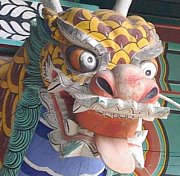
Dragon, Gapsa Temple
See above slideshow
|
|
DRAGON 龍 or 青龍 (C = Lóng, K = Yong 용, J = Ryū). The dragon is a protective deity throughout Asia, in all traditions, but especially found on ceiling paintings and architectural elements of Chan/Seon/Zen temples. The dragon is also one of the four celestial guardians of old China, in which it corresponds to the season spring, the direction EAST, the color green/blue, the element wood, and the virtue propriety; supports and maintains the country (controls rain, symbol of the Emperor's power). Often paired with the Phoenix, for the two represent both conflict and wedded bliss. In Asia, the dragon appeared in Chinese myth and artwork well before the introduction of Buddhism to China in the 1st & 2nd centuries CE. Japan's dragon lore comes predominantly from China. Images of the creature are found throughout Asia, where it was adopted as a protector of Buddhism, a symbol of imperial power, the guardian of the east, the controller of rain and tempests, and a magical shape shifter able to assume human form and mate with people. In contrast to Europe's malevolent dragon, the Asian dragon is considered benevolent, just, and the bringer of wealth.
THE CARP WHO BECAME A DRAGON. The carp (Jp. = Koi 鯉) transforming into a dragon is a common artistic theme in China and Japan. This theme is based on an old Chinese legend (Jp. = Koi-no-Takinobori 鯉の滝登り) wherein carp swim, against all odds, up a waterfall known as the "Dragon Gate" at the headwaters of China's mighty Yellow River. The gods are very impressed by the feat, and reward the few successful carp by turning them into powerful dragons. The story symbolizes the virtues of courage, effort, and perseverance, which correspond to the nearly impossible struggle of humans to attain enlightenment in the "muddy" material world. In modern Japan, temples and shrines commonly stock their garden ponds with carp, which grow to enormous sizes in a variety of colors. The sacred lotus is also found in great number in these ponds. The beautiful flower of the lotus symbolizes purity out of impurity, for it grows from the muck at the bottom of the pond. This is a metaphor for the gargantuan struggle of humanity to "attain enlightenment" while still planted in the "filth" of the material world, while still consumed by desire, greed, ambition, illusion, and other foibles.
LEARN MORE ABOUT THE DRAGON
|
|
TIGER LORE AND RESOURCES
|
|
|
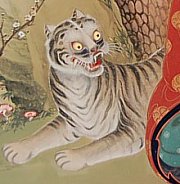
Tiger, Seokjongsa Temple
See above slideshow
|
|
TIGER 虎 or 白虎 (C = Hǔ, K = Ho 호, J = Tora). Lord of the West, corresponds to the direction WEST, the season fall, the color white, wind, the element metal, and the virtue righteousness. Often paired with the dragon in artwork in China and Japan. The tiger is one of four spiritual creatures (Sì Shòu 四獸) -- four celestial emblems -- each guarding a direction on the compass in old China. Japan's Nihon Shoki 日本書紀 (early 8th-century Japanese text) describes a Korean monk named Tokushi from Goguryeo, who is said to have learned agricultural techniques and the art of accupuncture from a "tiger" (this event is situated in Kōgyoku 4 [645 CE])
Says Bernhard Scheid on the PMJS list: Being anything but an expert of ancient Korean history I only know of the myth that the semi-god Hwanung [of Korea] who chose among a tiger (woman) and a bear (woman), eventually deciding for the bear. The child of this couple was Dangun, the mythical ancestor of all Koreans. Obviously the legend was recorded much later than the Ryoiki (early 9th c.) but if we assume an ancient origin, it may provide a certain clue to the question, who "tigers" in ancient Korea could be, namely a neighboring, but probably a "primitive" population (or perhaps the people from Silla from a Koguryeo/Baekje perspective?)
Says Lin Pei-Ying on the PMJS list: Those four-legged animals certainly bring vitality in monastic paintings! John Carpenter gave a presentation, "The Tiger in Zen Painting and Calligraphy" at the study day that Radu menioned. The tiger feature in religious contexts dating rather early; at least in the late sixth century, Chinese Daoist figure Zhang Daoling is depicted with a tiger, and the tame tiger is compared to a dog in a Daoist biography. In some ninth- and tenth- century Dunguang manuscripts, a mysterious arhat-figure termed a tiger-tamer 伏虎 occured. About the same time, the Zen tradition in China also acquired a tiger-keeper, the monk Fenggan. (See T. H. Barrett, in J. Benn, L. Meeks & J. Robson, eds., Buddhist Monasticism in East Asia, 2005. pp. 115-6.)
Says Schumacher: "In Korea, there are three spirits who are widely worshiped. (1) Mountain Spirit, who governs material wealth and is shown with a tiger; (2) Lord of the Big Dipper, who governs human fortune & longevity; and (3) Dokseong, an enlightened hermit who blesses the people. The three also represent (1) Shamanism, (2) Taoism, and (3) Buddhism respectively."
LEARN MORE ABOUT THE TIGER
|
|
TURTLE LORE AND RESOURCES
|
|
|
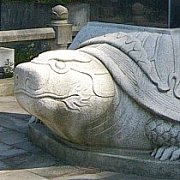
Turtle, Magoksa Temple
See above slideshow
|
|
TURTLE 龜 or 亀 or 玄武 (C = Guī, K = Gwi 귀, J = Kame). The turtle is one of Four Legendary Creatures (Chn. = Sì Shòu 四獸) guarding the four compass directions. Its imagery corresponds to north, winter, black, and the element water. It is a servant and messenger of the dragon. The tortoise is associated with long life, and in China, Korea, and Japan, a common artistic symbol for longevity is a snake embracing a tortoise (the snake & the dragon are essentially the same creature in most tales, both part of the NAGA group of serpentine creatures from Hindu lore). Grave steles, memorial stones, and reliquaries placed atop tortoise effigies can still be found in China, Korea, and Japan, and were reserved for only the highest ranking members of the imperial family or ruling classes, those who had made some major contribution to the nation. In Buddhist cosmology, the central mountain of the world rests upon a cosmic turtle lying at the bottom of the ocean. The tortoise is the hero of many old legends. It helped the first Chinese emperor to tame the Yellow River, and in return was rewarded with a life span of ten thousand years. Thus the tortoise became associated with long life. In both Chinese and Japanese artwork, a common symbol for longevity is a snake embracing a tortoise), for Chinese mythological says their union engendered the universe (there were no male tortoises -- as the ancients believed --- so the female had to mate with a snake). <see Derek Walters> In China, the tortoise-snake pairing dates back to the third century AD. In Chinese Qigong exercises, the snake/dragon (yang) is a symbol of dynamic potency, while the turtle (yin) is a symbol of stillness and endurance. Says the DDB (sign in with user name = guest): "The rarity of meeting a Buddha is compared with the difficulty of a blind sea-turtle finding a log to float on, or a one-eyed tortoise finding a log with a spy-hole through it."
LEARN MORE ABOUT THE TURTLE
|
|
LION LORE AND RESOURCES
|
|
|
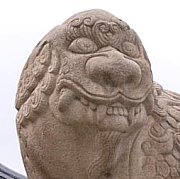
Lion, Chang Deok Gung Palace
See above slideshow
|
|
Lion protectors 獅子 (C = Sīzǐ, K = Saja 사자, J = Shishi) traditionally stand guard outside the gates of Buddhist temples in China, Korea, and Japan, and often appear as emblems on the armor of the Four Heavenly Kings or as protective architectural elements placed under the eaves of temple structures. The Chinese characters can also refer to a deer or dog with magical properties and the power to repel evil spirits. These mythical beasts were introduced from China to Korea, and from Korea to Japan. In Japan, the Koma-inu 狛犬 (Korean dog) is sometimes depicted with a horn atop its head. The name is derived from Koma 高麗, the Japanese term for the old Korean kingdom of Koguryo 高句麗. For reasons unknown (to me), the horn disappeared long ago, and rarely appears in artwork of the Edo-period onward. In China, the lion is the master of all felines, the defender of law, and the protector of sacred buildings. It is a symbol of power and success, and of royality and strenghth. Images of it were embroidered on court robes. In Korea, the skin on Koma-inu's head was believed to be stronger than a helmet. In Japan, the Shishi is a noble beast who protects the entrance to the temple/shrine, and in some cases, the tomb. Shishi nearly always come in mated pairs (male and female). Helena Burton at Oxford University says the Shishi is sometimes tattooed on a woman's belly to protect her during childbirth. Occasionally, Buddhist deities are depicted mounted on the beast, in particular Monju Bosatsu.
LEARN MORE ABOUT LION PROTECTORS
Lion Protectors with Magical Powers to Repel Evil (A-to-Z Dictionary) |
|
MAKARA LORE AND RESOURCES
|
|
|
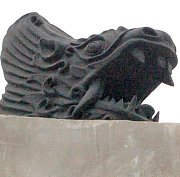
Makara, Gyeongbokgung Palace
See above slideshow
|
|
Makara 鯨魚 or 摩竭 (C = Jīngyú, K = Gyeongeo 경어, J = Keigyo). An ancient Vedic sea monster. They are sometimes positioned on the main ridge of temples and palaces in Korea and Japan, and are thought to provide protection against fire. Often described as having the body of a crocodile and other whimsical parts. In Southeast Asia, Makara frequently adorn temple lintels and arches, and are often depicted with a dragon emerging from their mouths. One of the main characteristics of the Makara in India and Southeast Asia is an elongated nose, like that of an elephant.
Onigawara 鬼瓦. Literally "Demon Tile" or "Goblin Tile." The goblin tile is an ornamental architectural element, a decorative roof element typically placed at the ends of the main ridge on temple structures and residences. These tiles serve decorative, functional, and protective roles in preventing weathering and in warding off evil spirits and fire.
LEARN MORE ABOUT MAKARA AND GOBLIN TILES
|
|
MONKEY LORE, ZODIAC LORE, OTHER RESOURCES
|
|
|
|